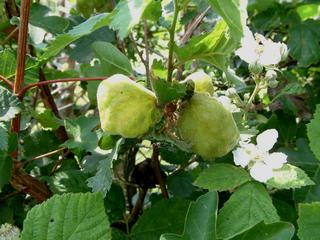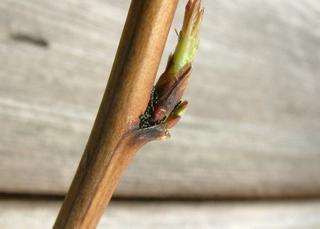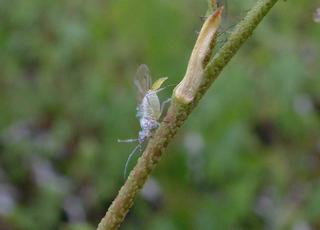 |
 |
| Elm leaf balloon gall caused by aphid Eriosoma lanuginosum. Pictures Roger Umpelby | |
Worcestershire Record No. 23 November 2007 pp. 33-34
Roger Umpelby
Given the number and diversity of different invertebrate groups and types, it is not surprising that some are rarely mentioned by naturalists. Looking back through the previous editions of Worcestershire Record I have not found a single article on aphids; this does not do justice to the significance of the group to a lot of our local wildlife. Even nationally aphids rarely get a mention, except when something ‘big’ is reported, such as the large oak aphid, Stomaphis quercus, ‘the biggest aphid in the world – the size of a coffee bean’.
There are about 4000 aphid species world-wide, with over 500 in the UK. Despite the relative lack of information from naturalists about aphids, the group is well studied. Aphids are of great interest to applied entomologists because of their economic role in agriculture and horticulture; consequently many of the pest species are well researched and studied. Apart from weakening plants due to feeding, and the contamination by honeydew, aphids transmit plant viruses, and some produce galls or other growth distortions. An example of an aphid induced gall is the elm balloon-gall aphid, Eriosoma lanuginosum, where the aphids feed inside the gall protected from predators, photos below.
 |
 |
| Elm leaf balloon gall caused by aphid Eriosoma lanuginosum. Pictures Roger Umpelby | |
Role in the food chain
Aphids probably provide food for a wider range of animals (in the broadest sense) than any other invertebrate group. They are prey for many other invertebrates, a number of bird and small mammal species, and even for some amphibians and reptiles. Additionally the copious quantities of honeydew they produce provide food for many invertebrates, plus they are hosts to a range of invertebrate parasites.
To quantify the amount of food aphids provide we need to use a real example:-
The damson-hop aphid, Phorodon humuli; under ideal conditions its size and reproductive details will be:-Life cycle
Aphid life cycles can be very complex and varied. All aphids reproduce asexually, by parthenogenesis, for at least part of their life cycle (see photo). Some species have no sexual stage; others may go for several years before having a sexual phase. The sexual phase is normally triggered by environmental factors such as day length and temperature, but it may be triggered by the health or seasonal status of the host plant. Most aphid species live on one host plant type (monoecious). About 10% of aphid species have two very different hosts, one in the summer and another in the winter (heteroecious). In heteroecious species, the sexual phase only occurs on one host, normally the winter host where hardy winter eggs are laid (see photo), but asexual reproduction occurs on both hosts. Most aphid species are host-specific, at least to plant family, but sometimes to genus. A few species are polyphagous but even this is limited; Myzus persicae, the most polyphagous of UK species, can feed on <1% of our flowering plant species.
 |
 |
| Hardy winter eggs | Silver Birch aphid giving birth |
| Pictures by Roger Umpelby | |
Aphid highlights in 2007
The very wet summer certainly slowed the population build-up of some species and infestation levels on grasses and low-growing herbaceous plants were considerably lower than average. However some of the larger aphids, particularly some of the tree aphids, thrived.
In May Harry Green passed me a query from a lady near Upton on Severn about problems with her blue spruce tree Picea glauca. The problem proved to be a heavy infestation of Cinara piceae, the greater black spruce bark aphid. This large aphid feeds on the stems, branches and trunk in dense colonies producing copious quantities of honeydew. The tree in question was almost completely covered in honeydew, much of it colonised by sooty mould. Despite the density of the aphids, the aphids would have disappeared by the end of the summer and the tree would show no long-term ill-effects, except for the sooty mould blackened bark and needles; and, re-assuringly for the lady, the aphids are very unlikely to re-appear next year. In contrast if the tree had been infested with the green spruce aphid, Elatobium abietinum, the needles would have gone brown and dropped and the tree would take many years to recover. C. Piceae is just one of 22 Cinara species in the UK.
In September Rosemary Winnall sent some pictures and observations about the large willow aphid, Tuberolachnus salignus, and I warmed to her description of them:- ‘They are distinctive and splendid beasts!’. Over the next couple of months we corresponded, exchanging observations, opinions and photographs, particularly relating to predation and where they go to in late winter. According to some authors predators and parasites are rarely seen attacking T. salignus. However Rosemary photographed the larva one of the Dasysyrphus species hoverflies feeding on T. salignus, and one of the colonies I watched was closely attended by harlequin ladybird adults, larvae and pupae (see photos).
This is a story that is sure to run – watch this space!
Perhaps now aphids will not be a neglected group.
| WBRC Home | Worcs Record Listing by Issue | Worcs Record Listing by Subject |